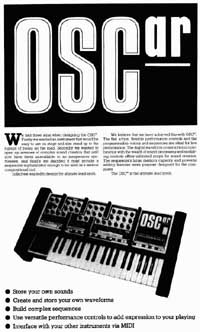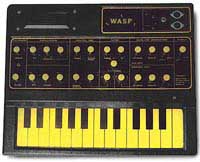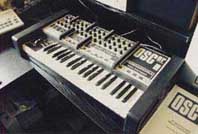INTRODUCTION
The Oscar (often styled OSCar) is a slightly obscure, mostly monophonic, largely analogue synthesiser that was produced during the 1980s. Although less well-known than landmark names such as the Minimoog, VCS3 or Sequential Pro One, the OSCar inspires a certain affection among a small band of devotees thanks to being packed with features that turned out to be way ahead of their time. I put this site together after finding there was no other website dedicated to this instrument and what little information existed was scattered around in disparate locations. The OSCar was an innovative and stylish piece of British technology and many examples continue to give sterling service. This is my humble attempt to pull together all the information I can find into a useful resource and to give some long overdue online recognition to this musical gem and its makers. The OSCar was the brainchild of UK designer Chris Huggett and its name derives from the initials of the Oxford Synthesiser Company, which was set up as a vehicle for his synthesiser ideas. Huggett later helped to design samplers for Akai and latterly worked for Novation on instruments including the BassStation and Supernova. He died of cancer in October 2020 and will be remembered as a technical pioneer who significantly influenced the evolution of modern electronic instruments. This website has no connection with Chris Huggett or his family or companies and is purely a "fansite" inspired by his designs.
|
||
- ROOTS -The Oxford Synthesiser Company was Huggett's second commercial venture into the dawning era of electronic music. He had previously been involved in the company Electronic Dream Plant Ltd, for which he designed a range of basic synthesisers, best known of which was the Wasp, released in 1978. While the Minimoog is remembered as the instrument that widened the use of synthesisers by making them small and affordable enough for professional touring musicians, the Wasp made the wacky, weird and gritty sounds of analogue synthesis accessible to ordinary people by being cheap and cheerful.
Described at the time as "One of the biggest advances in synthesiser design - an ultra low cost, high performance instrument", it was an odd looking device. Built in garish black and yellow plastic with a flat yellow keyless, two octave "keyboard", it weighed no more than a couple of pounds. It had two digitally controlled oscillators running through an analogue filter which gave the instrument a distinctive and powerful sound belying its cheap-and-cheerful appearance. Other products from Electronic Dream Plant were:
Wasps were used by a number of well-known groups and you can still find secondhand ones advertised quite frequently. At least one company, Analogue Solutions, has produced kits to add additional features to the Wasp. - THE OXFORD SYNTHESISER COMPANY -The OSCar was Huggett's attempt to build a sophisticated performance synthesiser with state-of-the-art sounds, yet still at an affordable price. It was a compact dual oscillator analogue-digital hybrid built into a substantial rubberised casing with a full-size three-octave keyboad. I described it at the top of this page as largely analogue because although it has much in common with classic analogue synthesisers and its sounds emerge from analogue circuits it has a control system and additional features that are products of digital technology. The synth has two wide-range digitally controlled oscillators (DCOs), capable of producing both conventional analogue waveforms and programmable additive waveforms. I used the description "mostly monophonic" at the top of the page because the two oscillators can be set to respond to the keyboard independently thus giving a duophonic effect. There is also a separate white noise source. A vital feature of any analogue synth is its filtering and the OSCar is strong in that department. Like the Wasp, from which it evolved, it has analogue filtering but with greater flexibility and control. There are two 12dB/oct filters which can be linked for a steeper 24dB/oct response or separated for subtler effects. They can work as low-pass, high-pass or band-pass (when one is effectively high-pass and the other low). There are two ADSR envelope generators - one for filtering and other tonal dynamics and one dedicated to the output amplifier. There is also a low frequency oscillator (LFO). All of these elements have a wide range of control options that allow them to work together in different ways as well as to link and respond to other signals, such as sequencer triggering. OSCar had many innovative features but perhaps the most useful for performers was the fact that voices were programmable. At that time most other analogue synths suffered from the disadvantage that in order to recreate a sound setting you had to remember where you set all the various knobs and switches. OSCar's knob settings could be stored in a digital memory, which allowed you to hold up to 32 different "patches" and recall any one at the push of a couple of buttons. All this while retaining the classic and instinctive arrangement of separate knobs for each parameter - unlike many other programmable synths of the time that required users to enter numbers through multi-purpose buttons and to learn seemingly endless levels of menus. Another selling point, and one which distinguishes OSCar from many of its contemporaries, is that from September 1984 there was MIDI. Although OSCar has a fairly basic MIDI spec compared to modern keyboards, it is perfectly serviceable. (I've used my OSCar as a controller keyboard. Its only failing in that role is its lack of velocity or aftertouch functions - but with my playing that's almost irrelevant!) The OSCar came with various automatic playing features. There was an arpeggiator; there were various arrangements for repeatedly triggering envelopes under the control of either an internal clock or external sync; and perhaps most forward looking of all, there was an inbuilt sequencer - initially capable of storing up to 580 steps and expanded in later models to 1,500 steps. This made the OSCar a tenuous ancestor of sophisticated "music workstations". It has to be said that although the sequencer is theoretically capable of complex compositions the lack of a visual display makes it fiendishly awkward to program. Editing and complex tunes are virtually impossible. Despite these limitations the sequencer offered some useful creative possibilities when used in combination with other features such as the duophonic mode. The original retail price of the OSCar was UK£599 and approximately 2,000 are said to have been built during the short lifespan of the Oxford Synthesiser Company. Huggett's ideas seem to have been constantly racing ahead and there were numerous revisions to the specification during the production run. Had the company been as successful financially as it was technically then there is no knowing what OSCar would have evolved into. At a trade show in Frankfurt in 1985 the company exhibited a rackmounted polyphonic synth module called the ASG (for Advanced Sound Generator), which used 16 OSCar voice cards. As well as the digital additive synthesis featured in the OSCar, the new synth could use its digital oscillators to play back sampled sound. It was clearly marching into the territory of megabuck machines such as the PPG Wave, Synclavier or Fairlight. But the company was short-lived and Huggett moved on to other projects. (He worked for Akai on the operating system for its S1000 sampler and more recently he has worked for Novation - a British company which has combined analogue sounds with modern control technology) The OSCar's downfall was that it quickly ended up having to compete with new polyphonic programmable MIDI synths produced by the likes of Casio and Yamaha. Very soon the DX7 arrived and became the "must have" synth for 1980s pop bands as well as an infinitely complex sound design tool for Brian Eno. And for those eclectic souls who still wanted analogue then Sequential Circuits or Roland were offering OSCar's programability and MIDI features but in polyphonic machines. Nonetheless, OSCar lives on. It is one of many vintage synths to win new fans following the revival of analogue sounds through dance music. Thanks to Chris Huggett's foresight it can link up to modern MIDI systems more easily than other vintage analogue synths. Its digital control system means that its tuning is much more reliable than notoriously unstable analogue contemporaries. And, best of all, it offers a wide range of great analogue sounds with all the infinite "tweakability" that you get from having a user interface consisting of loads of knobs rather than a few push buttons. Well known artists credited as using OSCars include:
Examples of OSCar sounds on commercial releases include:
(The source for these two lists was a "retrozone" article in the September 1999 issue of Sound On Sound magazine written by Paul Wiffen who was involved in the development of the OSCar) - My OSCar ----------------- |


